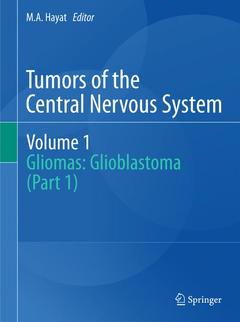Tumors of the Central Nervous System, Volume 1, 2011 Gliomas: Glioblastoma (Part 1) Tumors of the Central Nervous System Series, Vol. 1
Coordonnateur : Hayat M. A.

Introduction. 1. introduction. 2. molecular classification of gliomas. i.biomarkers and diagnosis. 3. glioblastoma: endosialin marker for pericytes. 4. glioma grading using cerebral blood volume heterogeneity. 5. the role of ectonucleotidases in glioma cell proliferation. 6. gliomas: role of monoamine oxidase b in diagnosis. 7. glioma: role of integrin in pathogenesis and therapy. 8. proton magnetic resonance spectroscopy in intracranial gliomas. 9. infiltration zone in glioma: proton magnetic resonance spectroscopic imaging. 10. malignant gliomas: role of e2f1 trascription factor. 11. the role of glucose transporter-1 (glut-1) in malignant gliomas. 12. malignant gliomas: role of platelet-derived growth factor receptor a (pdgfra). 13. molecular methods for detection of tumor markers in glioblastoma. 14. role of mgmt in globlastoma. 15. glioblastomas: role of cxcl12 chemokine. 16. cell death signaling in glioblastoma multiforme: role of the bcl2l12 oncoprotein. 17. glioblastoma multiforme: role of polycomb group proteins. 18. glioblastoma multiforme: role of cell cycle-related kinase protein (method). ii.neural stem cells and cancer stem cells. 19. markers of stem cells in gliomas. 20. efficient derivation and propagation of glioblastoma stem-like cells under serum-free conditions using the cambrige protocol. 21. glioma cell lines: role of cancer stem cells. 22. glioblastoma cancer stem cells: response to epidermal growth factor receptor kinase inhibitors. iii.therapy. 23. low-and high-grade gliomas: extensive surgical resection. 24. brainstem gangliogliomas: total resection and close follow-up. 25. glioblastoma: temozolomide-based chemotherapy. 26. drug-resistant glioma: treatment with imatinib mesylate and chlorimipramine. 27. glioblastoma multiforme: molecular basis of resistance to erlotinib. 28. enhanced glioma chemosensitivity. 29. malignant glioma patients: anti-vascularendothelial growth factor monoclonal antibody, bevacizumab. 30. aggravating endoplasmic reticulum stress by combined application of bortezomib and celecoxib as a novel therapeutic strategy for glioblastoma. 31. targeted therapy for malignant glimas. 32. glioblastomas: her1/egfr-targeted therapeutics.33. epidermal growth factor receptor inhibition as a therapeutic strategy for glioblastoma multiforme. 34: role of acyl-coa symthetases in glioma cell survival and its therapeutic implication. 35. maglignant glioma patients: combined treatment with radiation and fotemustine. 36. malignant glioma immunotherapy: a peptide vaccince from bench to bedside. 37. malignant glioma: chemovirotherapy. 38. intracranial glioma: delivery of an oncolytic adenovirus. 39. use of magnetic resonance spectroscopy imaging (mrsi) in the treatment planning of gliomas. 40. malignant glima cells: role of trail-induced apoptosis. iv.prognosis. 41. long-term survivors of glioblastoma. 42. glioblastoma patients: p15 methylation as a prognostic factor.
Date de parution : 04-2013
Ouvrage de 434 p.
19.3x26 cm
Date de parution : 03-2011
Ouvrage de 434 p.
19.3x26 cm
Thèmes de Tumors of the Central Nervous System, Volume 1 :
Mots-clés :
Chemotherapy; Diagnosis; Glioblastoma; Radiotherapy; Surgical Resection



